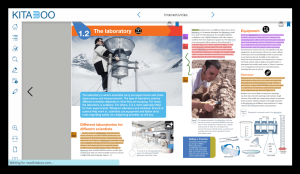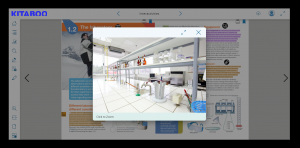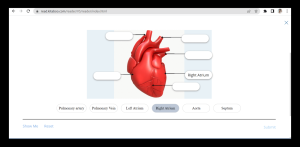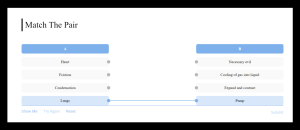Academic institutions are moving away from the traditional classroom and adopting online and blended teaching methods like LMS integration in tune with the evolving trends. The COVID-19 pandemic has given a huge impetus to online learning and development, and even when it is showing signs of receding, online practices have become the new normal. In the era of technology and digitalization, traditional methods are either becoming obsolete or only working in tandem with modern technology.
The question then is, what does the ideal blend of teaching-learning methods for the current context look like? It is the combination of the flexibility offered by self-directed learning on one hand, with the rigorous testing permitted by LMSes on the other. In all this integration and good intention, it is extremely important to keep in mind that adding a new system should provide better functionality, but NOT add to the complexity of the user experience. Therefore, seamless integration is imperative. In this article, let us explore this idea in greater detail.
What is a Learning Management System?
For large corporates and educational institutions, a learning management system (LMS) is a means to deliver learning and development initiatives at scale to the employees or students and provide ongoing support in their individual learning journeys. It gives L&D departments the ability to control the training sequence and content, in an attempt to ensure that regulatory training is completed, and competency gaps are adequately addressed in a timely manner by employees. Going beyond this role, an LMS also facilitates an organization’s expansion efforts, builds its brand, stays competitive, and achieves its business goals. Leveraging the LMS platform, you can deliver, manage and track computer-based training and learning to employees, students, and clients. You can also develop and deploy personalized training at scale and identify areas for improvement, in the learners, instructors, and the course content. In a nutshell, the larger the organization, the more would be the requirement for such a platform. The importance of the LMS in training and development can be gauged from the fact that it is projected to grow by 7.2 percent annually through 2025.
Some of the benefits of LMS are listed below:
Deliver training
You can deliver training at scale, and across geographies and time zones cost-effectively. With the LMS, you can deliver Internet-based training, computer-based training, and blended learning, combining both offline and online learning. The course content is usually located in a cloud-based repository and people with authorization can log in with their credentials and access the training and course material. Further, they can revisit the training content as many times they want from anywhere and anytime and learn at their own pace and convenience, in the comfort of their own space.
Track and monitoring
Real-time tracking, reporting, and analytical tools in the LMS allow you to assess the quality and impact of your training based on predefined metrics and data visualization. Instructors and course administrators can understand the effectiveness of the training and the progress of each learner individually. The learners can also trace their progress and identify their pain areas.
Provide media-rich content
An LMS allows you to deliver digitally enabled interactive content that is immersive and engaging, while at the same time, challenging the learners to adopt a problem-solving approach to learning.
More personalized learning experience
In a traditional classroom setting, an instructor delivers the lesson to a class comprising all types of learning abilities. As a result, a few learners may follow the lesson while the rest become demotivated from learning. An LMS, on the other hand, enables the delivery of personalized learning experiences that allow learners to learn at their own pace, in their own space, and on the device of their choice.
Integrating LMS-es with KITABOO, the eReader - why?
KITABOO, the world’s leading digital publishing platform with 20 million+ users across the globe adopts advanced technological features apt for big companies, schools, universities, corporates, and enterprises. It brings in the additional value that the LMS misses, and when integrated with an LMS, it is a powerhouse duo.
Security, without the hassle of complexity
Although an LMS can easily deliver learning at a large scale, it lacks a range of multiple functionalities. An LMS integrated with KITABOO can deliver secure content with DRM protection. If one is worried about having to log in to multiple systems, remember multiple passwords, etc. this is a non-issue. Due to single sign-on and LTI integration possibilities, content can be launched from the LMS, and be securely delivered on KITABOO eReader, without any need for the user to log in again.
The idea that integration means increased complexity, is an outdated concept. KITABOO provides easy integration options that are as simple as Plug & Play in many cases. Further, when integrated in this manner, there are options for auto-rostering, single sign-on, trust-based authentication, etc. that make the entire process transparent to the end-user. This means that the LMS user gets access to secure content on KITABOO with no fuss whatsoever.
Integrated content experience
Imagine a link to a Biology book in an LMS integration. The student logs in, sees the resource link, and launches it. The system launches the book and opens the book where the user had last left off. The student flips the book pages on his device for a smooth reading experience, changes the font size as needed, and scrolls through the book in his favorite ‘Sepia mode’. He reads about the structure of the leaf, and right next to it there is an icon indicating “view the leaf up close”. He clicks on that icon and a full-size, high-resolution image pops open giving a detailed, sharp, minute view of the leaf and its components. He then closes it, continues reading, and reaches the section on photosynthesis where an embedded video demonstrates how photosynthesis actually happens. In another place, a laboratory is being discussed. A full-size image allows the user to imagine a laboratory much better than words can say.
At the end of the chapter, there is a summary slide of key ideas and a “check your understanding” section with multiple-choice questions, image labeling diagrams, fill-in-the-blanks questions, and even a crossword puzzle. The student takes this “formative test” and based on the system’s feedback re-learns the portions that were poorly understood and repeats the test till he is convinced that he has learned well.
He can do all this offline while traveling by train underground, and then sync everything when he comes back into an area with good internet connectivity. If you notice, none of this had any login hassles or content searching waste of time. What has been indicated above is only one of many thousands of possibilities of engaging the user with an eBook even as the focus is on well-connected and well-absorbed learning.
Related read: A Comprehensive Guide to Creating Interactive Workbooks for Schools
KITABOO facilitates key LMS integration
An LMS that functions in isolation cannot realize its full potential. Therefore, it becomes essential to integrate any LMS system with a secure digital publishing platform like KITABOO. KITABOO, the world’s leading digital publishing, and content delivery platform offers seamless integration with the popular LMSs such as Moodle, Schoology, Sakai, etc, and any LMS that supports LTI 1.1 and LTI 1.3. Let us take a close look at these LMSes and their functionalities.
Moodle
The Moodle (Modular Object-Oriented Dynamic Learning Environment) LMS is one of the world’s most popular learning management systems, primarily because it is flexible, free to download, and open source. Open-source implies that you can run, share, study and modify the software to your unique needs, with the appropriate attributions. This LMS serves the online learning and training needs of all types of learners from academic institutions to corporate training. Moodle LMS is used to deliver online learning and training, on-boarding training, skill-based training, and product launches. Apart from providing a wide range of tools that support learning, communication, and collaboration, Moodle also helps to address security concerns by defining who can access and manage user access.
Sakai
This learning management system offers tools and features that enhance teaching, learning, and collaboration. It also has robust group-aware tools and communication tools to facilitate group learning and team activities. For assessment, it offers rubric-based scoring, grade entry capabilities, and high-stakes testing.
Schoology
This LMS, as the name suggests, is very popular with the school community, or in other words, in K-12 education. It offers several in-built instructional tools to design courses and assessments. Besides, instructors and course admins can also use features such as discussion boards, packets, and quizzes to create assessments and interact with the learning community. In fact, Schoology takes collaboration to the next level, allowing collaboration not just between the instructors and learners but also parents through system-wide messaging features.
Related Read: Leveraging Digital Publishing Platforms with DRM for Secure Content Distribution
KITABOO Supports LTI 1.1 and LTI 1.3 LMS Integration
KITABOO can be integrated with any LMS that supports LTI 1.1 and LTI 1.3. An award-winning content publishing platform from Hurix Digital, KITABOO offers cutting-edge tools, features, and capabilities that greatly enhance the experience of publishers, educational institutions, and end-learners. By integrating KITABOO into your existing LMS, you can greatly enhance the delivery of interactive engaging content, ease the administration process for institutions, and leverage key analytical features to ensure the most out of your existing LMS and KITABOO.
While an LMS greatly eases the process of delivering learning at scale, this should not be the only factor to consider while selecting an LMS. It is equally important to understand how well it integrates with content publishing platforms. An LMS that functions in isolation cannot realize its full potential. Therefore, it should integrate with third-party services. KITABOO, the world’s leading digital publishing, and the delivery platform offer seamless integration with the popular LMSs such as Moodle, Schoology, Sakai, etc, and any LMS that supports LTI 1.1 and LTI 1.3. To know more, please write to us at kitaboo@hurix.com
Discover How An Ebook Conversion, Publishing & Distribution Platform Can Help You
Kitaboo is a cloud-based content platform to create-publish & securely distribute interactive mobile-ready ebooks.
You May Also Like












